With longer days and warmer temperatures, flowers begin to emerge, and life returns to our gardens. Tulips, daffodils, and crocuses are common sights in spring gardens, but if you crave a wilder look to your landscape, you may want to try out native spring ephemerals.

Spring ephemerals are early emerging plants that are often native to woodland areas with moist and rich soil. Since they’re some of the first plants to bloom, they’re an important source of nectar and pollen for pollinators and other beneficial insects.
As their name implies, spring ephemerals have short-lived flowers, and both flowers and foliage fade and die back as temperatures climb. But though these plants may disappear from your garden in the warmer months, their roots are still growing vigorously beneath the soil, ensuring that these plants will rebloom again next spring!
In this guide, we’ve collected some of our favorite early-blooming spring ephemerals. These dainty flowers will look stunning in your garden, and since many are native, they require less fuss than non-native ornamentals.
Jump to:
- 21 spring ephemerals for early garden color
- 1. Bloodroot (Sanguinaria canadensis)
- 2. Celandine poppy (Stylophorum diphyllum)
- 3. Marsh marigold (Caltha palustris)
- 4. Trout lily (Erythronium americanum)
- 5. Pasqueflower (Pulsatilla spp.)
- 6. Virginia bluebells (Mertensia virginica)
- 7. Trillium (Trillium spp.)
- 8. Yellow fritillary (Fritillaria pudica)
- 9. Mayapple (Podophyllum peltatum)
- 10. Sundial lupine (Lupinus perennis)
- 11. Squirrel corn (Dicentra canadensis)
- 12. Hepatica (Hepatica spp.)
- 13. Wild hyacinth (Camassia scilloides)
- 14. Ramps (Allium tricoccum)
- 15. Rue anemone (Thalictrum thalictroides)
- 16. Jack-in-the-pulpit (Arisaema triphyllum)
- 17. Dogtooth violet (Erythronium dens-canis)
- 18. Shooting star (Primula sect. Dodecatheon)
- 19. Spring beauty (Claytonia virginica)
- 20. Dutchman’s breeches (Dicentra cucullaria)
- 21. Bitterroot (Lewisia rediviva)
- Planting spring ephemerals
- Conscious gardening
- Summary
21 spring ephemerals for early garden color
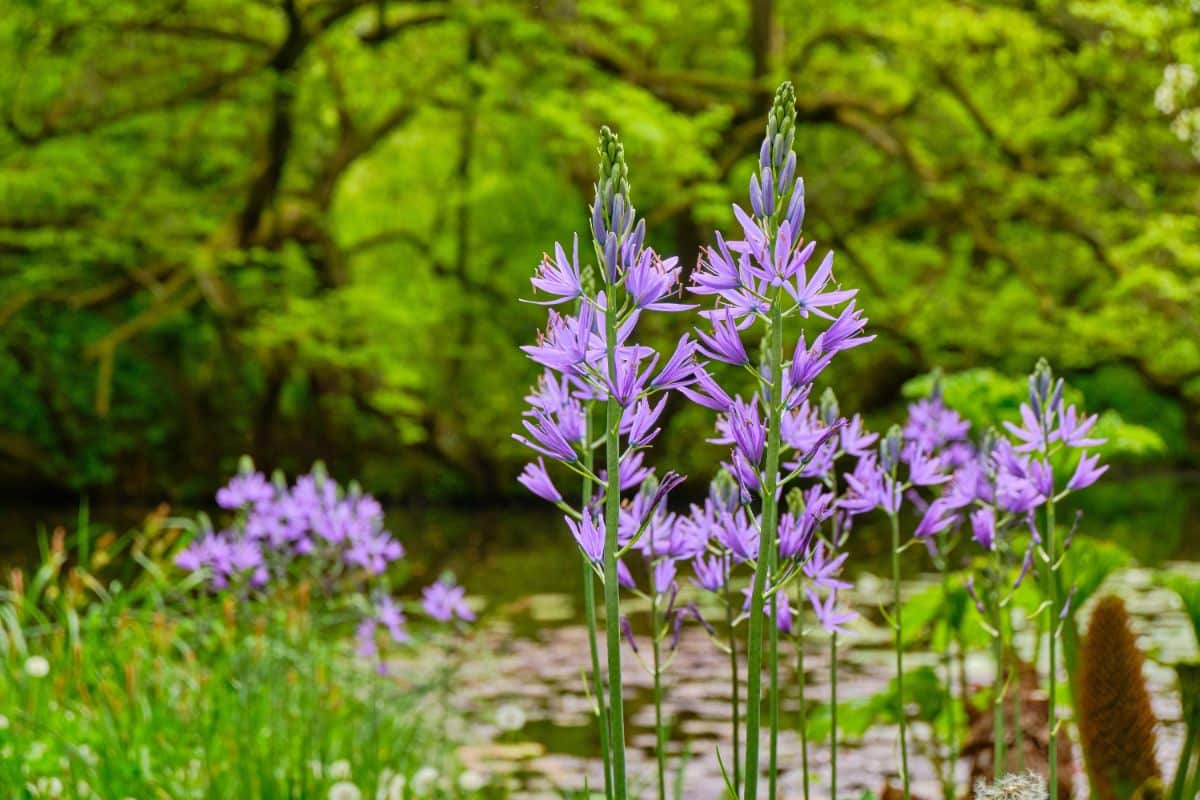
Below are some of our favorite spring ephemerals. Many of these plants can be found at local garden centers, or you can order seeds, rootstock, or potted plants online from a wide range of plant nurseries. Websites that specialize in native plants, wildflowers, and medicinal herbs are usually some of the best sources for spring ephemerals.
1. Bloodroot (Sanguinaria canadensis)
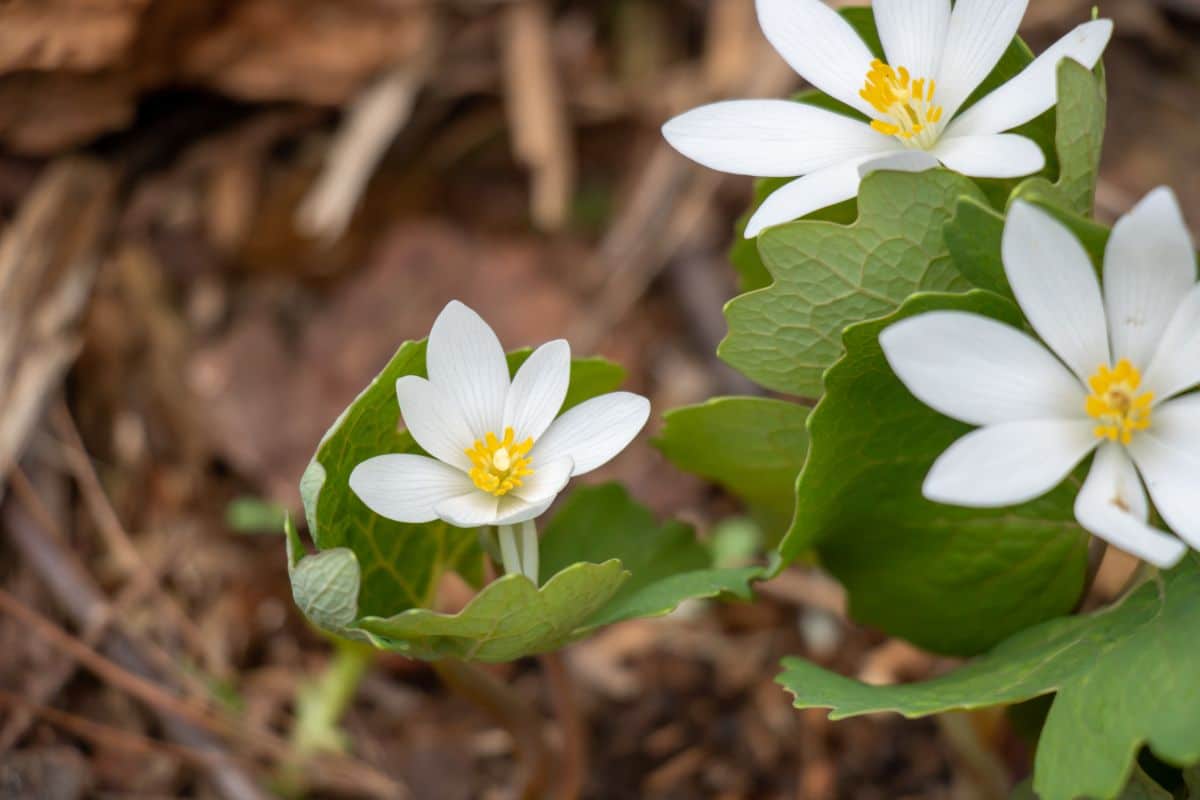
| Plant name: | Bloodroot |
| Light requirements: | Shade |
| Water requirements: | Moderate to low |
| Growing zone: | Zones 3 to 8 |
| Where to buy: | American Meadows |
When it comes to spring ephemerals, one of the most famous and easiest to find is bloodroot. Bloodroot plants are often available for sale at local nurseries, especially if those nurseries specialize in native wildflowers. A very striking plant, bloodroot produces lobed leaves and delicate, white flowers, and it grows best in the shade.
Named for its dark red sap, bloodroot was first used as a dye by Native Americans, and it is still often used as a natural dye by crafters today. Just keep in mind that bloodroot sap can cause rashes or even burns to the skin, so it’s important to always wear gloves when handling this plant.
2. Celandine poppy (Stylophorum diphyllum)
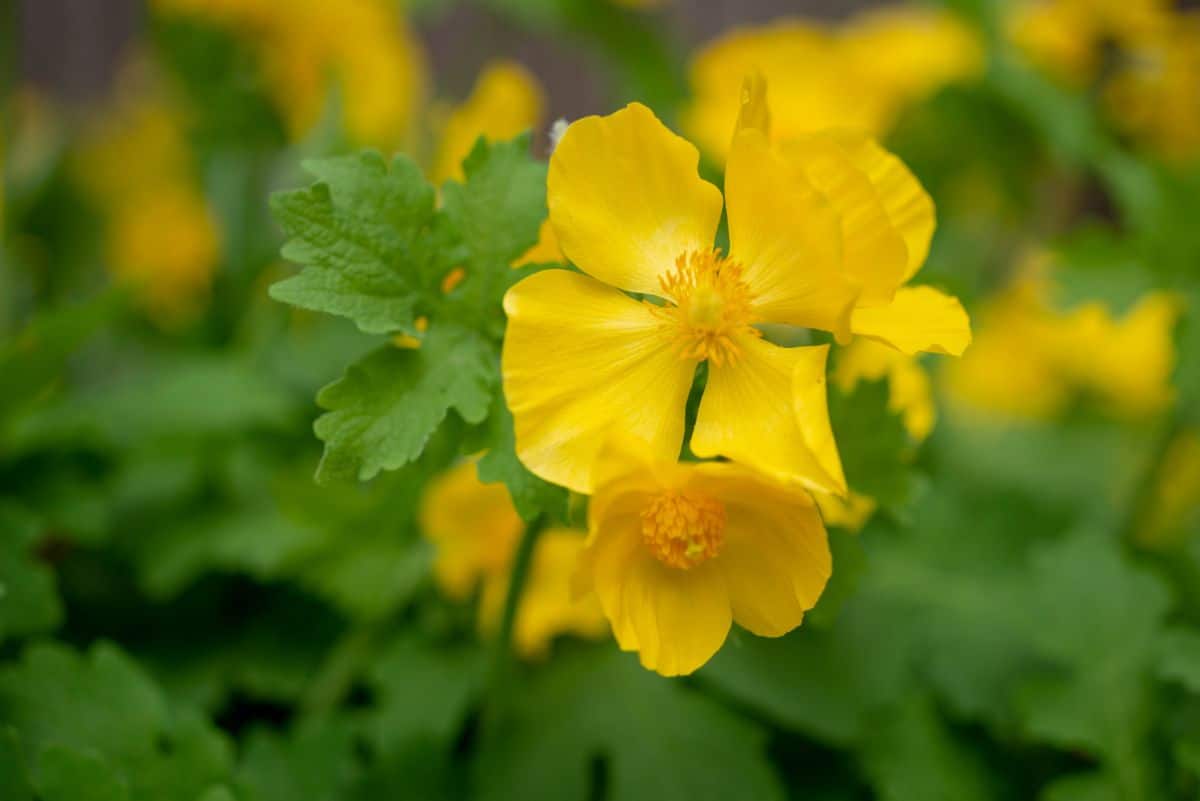
| Plant name: | Celandine poppy |
| Light requirements: | Shade |
| Water requirements: | Moderate |
| Growing zone: | Zones 4 to 9 |
| Where to buy: | American Meadows |
Celandine poppies are like little rays of sunshine in the garden. Their bright yellow flowers look similar to buttercups, but the blooms appear earlier and are differently shaped. One of the easiest ephemerals to grow, celandine poppies prefer moist soil and at least partial shade.
Some ephemerals can be very difficult to start from seed, but not celandine poppy. Celandine poppy is a great choice for beginners, and it also readily self-sows. Like bloodroot, celandine poppies were also used by Native Americans to produce natural dyes.
3. Marsh marigold (Caltha palustris)
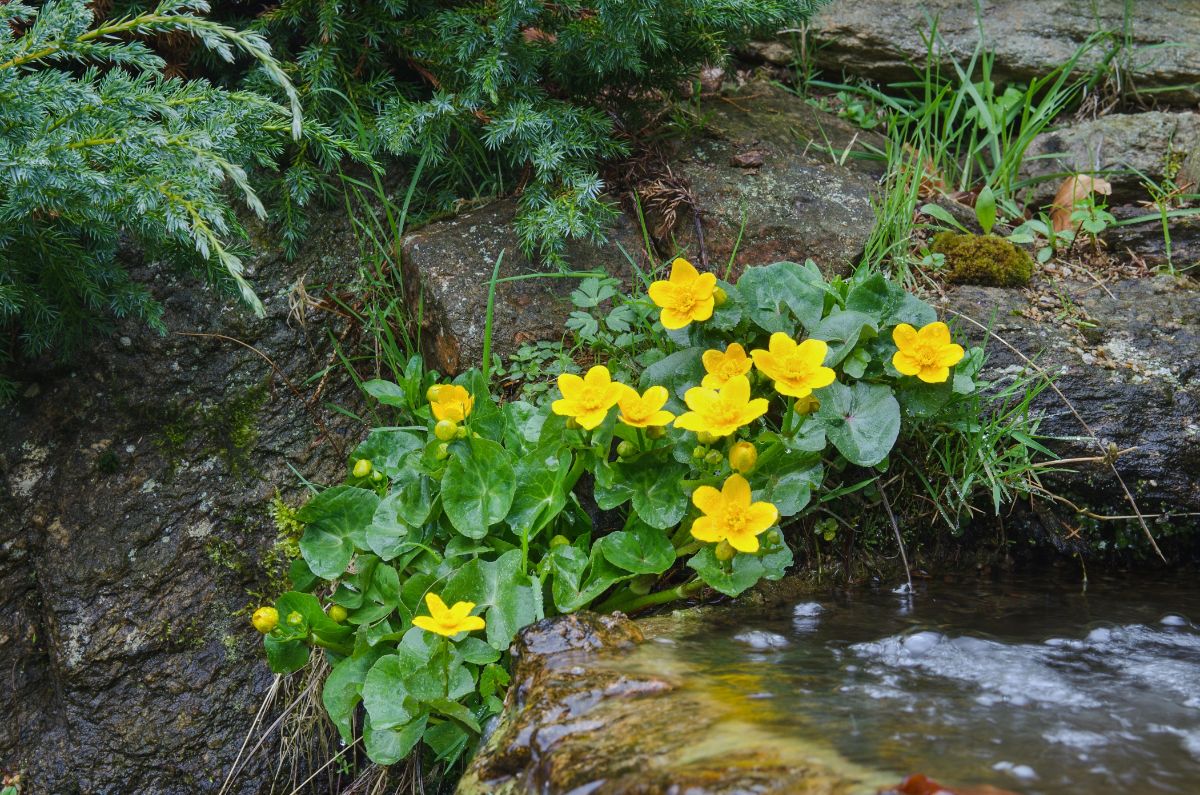
| Plant name: | Marsh marigold |
| Light requirements: | Full sun to part shade |
| Water requirements: | High; can be planted in up to 6” of water |
| Growing zone: | Zones 3 to 7 |
| Where to buy: | Amazon |
Marsh marigolds look a bit like celandine poppies, but these water-loving plants are mostly found in boggy areas. Because they grow best in moist soil, marsh marigolds are suitable for water gardens and for framing backyard ponds. In fact, they can be sown in up to 6” of water!
After planting, marsh marigolds are very easy to keep, and they don’t require a lot of maintenance. Just monitor your plants to make sure they don’t get too dry, and provide them with a bit of extra shade if you live in a very warm location.
4. Trout lily (Erythronium americanum)

| Plant name: | Trout lily |
| Light requirements: | Full sun to part shade |
| Water requirements: | Moderate |
| Growing zone: | Zones 3 to 9 |
| Where to buy: | American Meadows |
Trout lilies have very distinct yellow blooms with fine petals that arch backward toward the plant’s stems. These open blooms create lovely texture in garden beds and also make it easy for pollinators to access the plant’s nectar and pollen.
Sometimes gardeners will struggle to get trout lilies to flower, but this is usually due to soil that is too rich in nutrients. To avoid this, cut back on fertilizer and rake away extra leaf litter to keep it from breaking down in your garden beds. Additionally, since trout lilies don’t like having their roots disturbed, it’s best to avoid moving them once they’ve arrived in your garden.
5. Pasqueflower (Pulsatilla spp.)
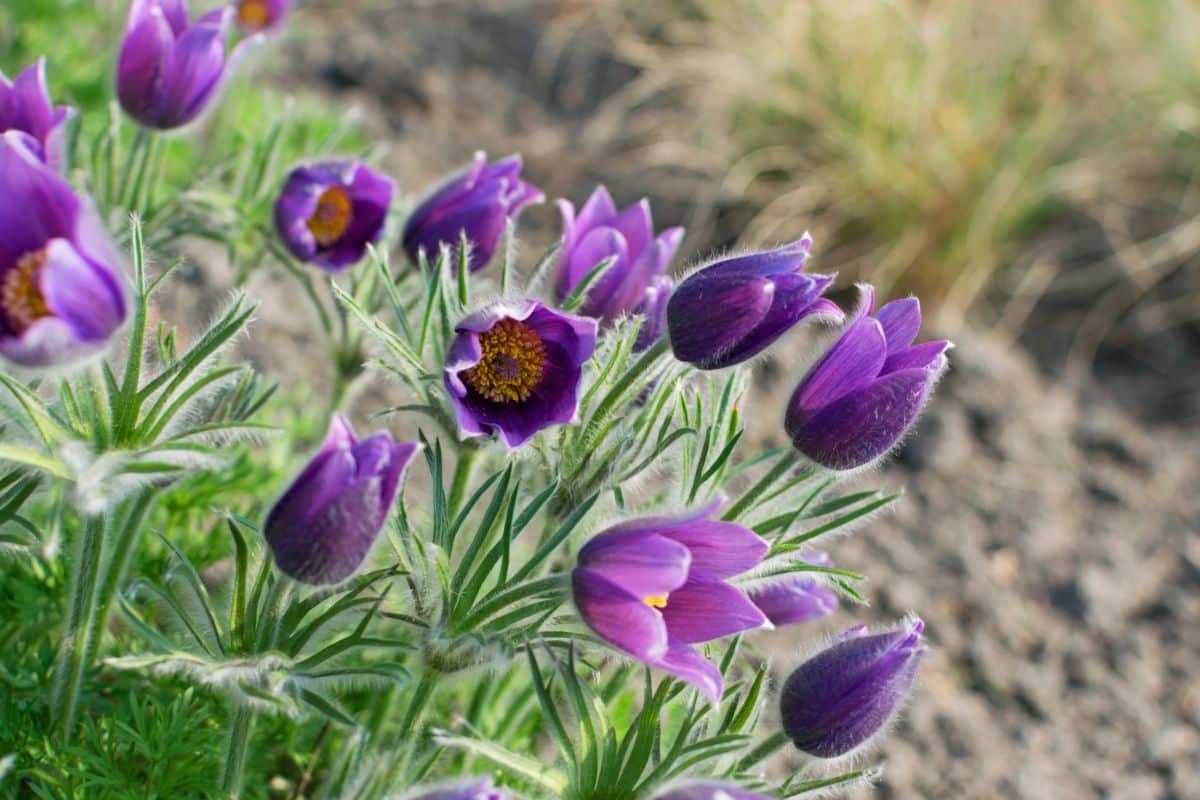
| Plant name: | Pasqueflower |
| Light requirements: | Full sun |
| Water requirements: | Moderate |
| Growing zone: | Zones 4 o 8 |
| Where to buy: | Amazon |
‘Pasque’ means ‘Easter’ in old French, which refers to the bloom time of this charming ephemeral. Pasqueflowers generally emerge in early spring, around the same time crocuses will be popping up in your beds. However, these unique-looking plants feature pointed, purple petals and fuzzy leaves that add a touch of whimsy to spring gardens.
Pasqueflowers are a favorite of bees, especially since they bloom before many other flowers. Well-draining soil is critical for keeping pasqueflowers happy, as they can be prone to root rot in soggy areas. If you want to try out these ephemerals, it’s easiest to grow pasqueflowers from started plants because seeds can be tricky to germinate.
6. Virginia bluebells (Mertensia virginica)
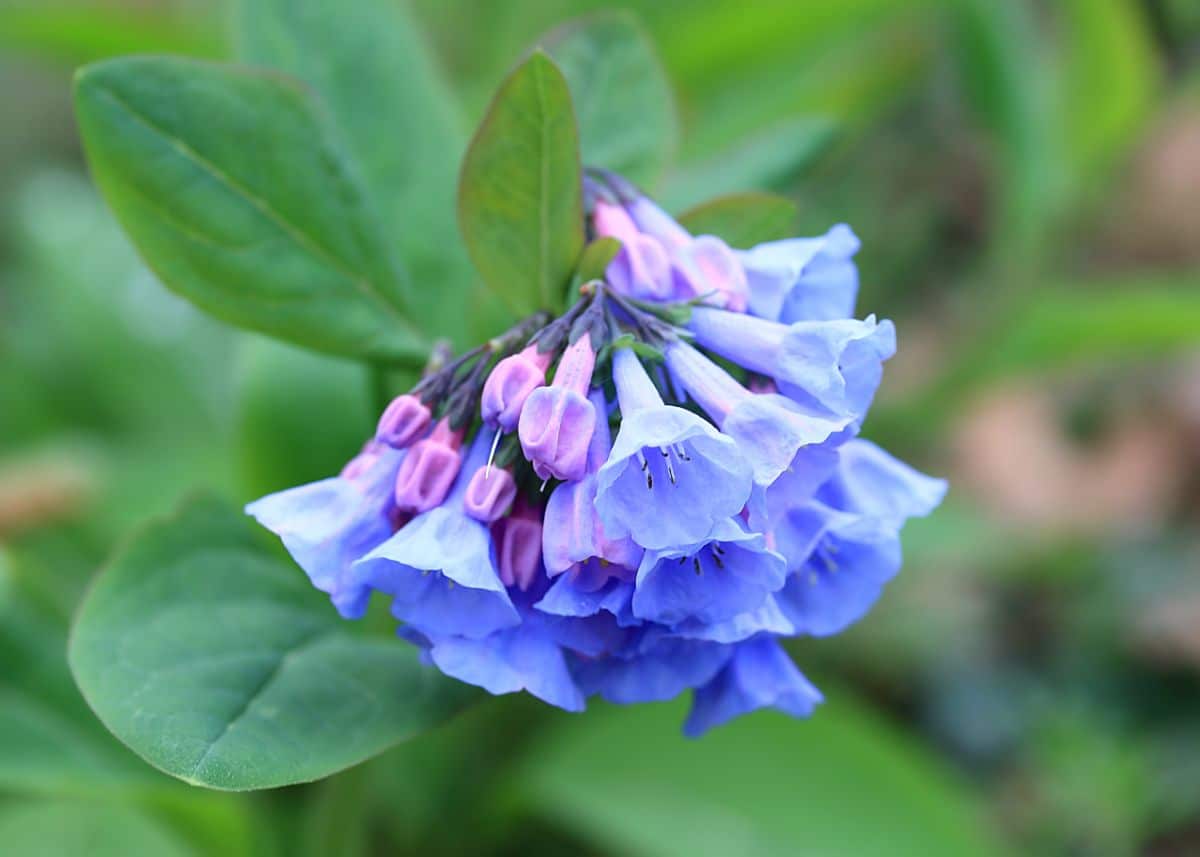
| Plant name: | Virginia bluebells |
| Light requirements: | Shade |
| Water requirements: | Moderate |
| Growing zone: | Zones 3 to 8 |
| Where to buy: | American Meadows |
Virginia bluebells are taller than many other ephemerals and usually max out at around 2’ feet tall. That makes them good choices for the center of garden beds, but they can be grown in containers too. Bluebells are also ideal for beginners, and they readily self-sow.
Virginia bluebells are related to borage, and, like borage, they have pink and blue flowers. These plants look best when sown in clumps of at least 3 plants, which will also make it easier for pollinators to find them. Once the blooms and leaves of these ephemerals fade back into the soil, freshen up your beds with a thin layer of mulch spread over your plants.
7. Trillium (Trillium spp.)
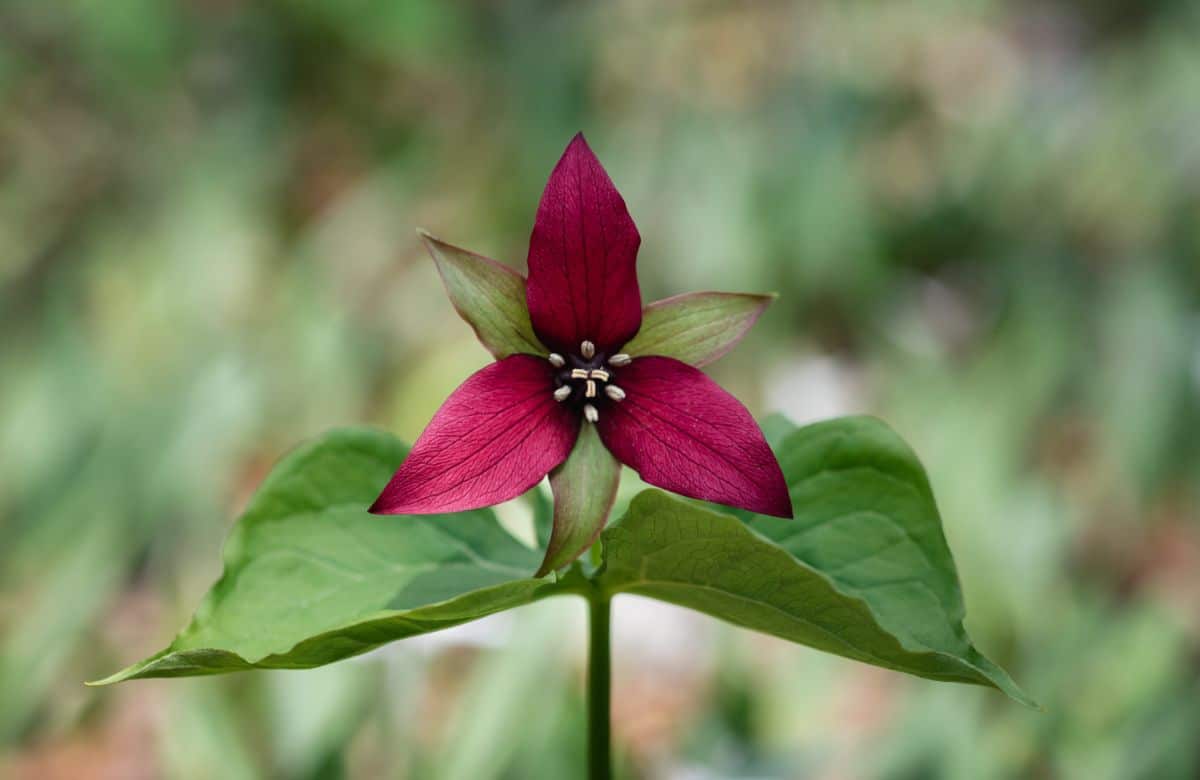
| Plant name: | Trillium |
| Light requirements: | Shade |
| Water requirements: | Moderate to low |
| Growing zone: | Zones 4 to 9 |
| Where to buy: | American Meadows |
Trillium is named for its flowers, which have three large and well-formed petals. Flowers come in a range of colors, but white and purplish-red are the most common. Often found in colonies in wooded areas, trillium prefer shady spots and rich, well-draining soil.
If you want to keep trillium, you’ll need to be patient because these slow-growing plants can take up to 7 years to flower. It’s also important to know your supplier since wild trillium plants are often overharvested, and this can compromise the plants and damage the ecosystem around them. Instead, look for cultivated trillium varieties, and don’t add much fertilizer to your plants because they don’t need it!
8. Yellow fritillary (Fritillaria pudica)

| Plant name: | Yellow fritillary |
| Light requirements: | Full sun to part shade |
| Water requirements: | Moderate |
| Growing zone: | Zones 3 to 7 |
| Where to buy: | Amazon |
Yellow fritillaries are hardy ephemerals that can even push their way through the snow in early spring. That said, they can be rather difficult to grow unless you can achieve growing conditions that are similar to their native grasslands.
Preferring sunny locations, yellow fritillaries need rich, well-draining soil. If your soil is subpar, you may want to amend it with compost and sand or perlite. Fritillary flowers come in yellow and orange and are a hit with pollinators.
9. Mayapple (Podophyllum peltatum)
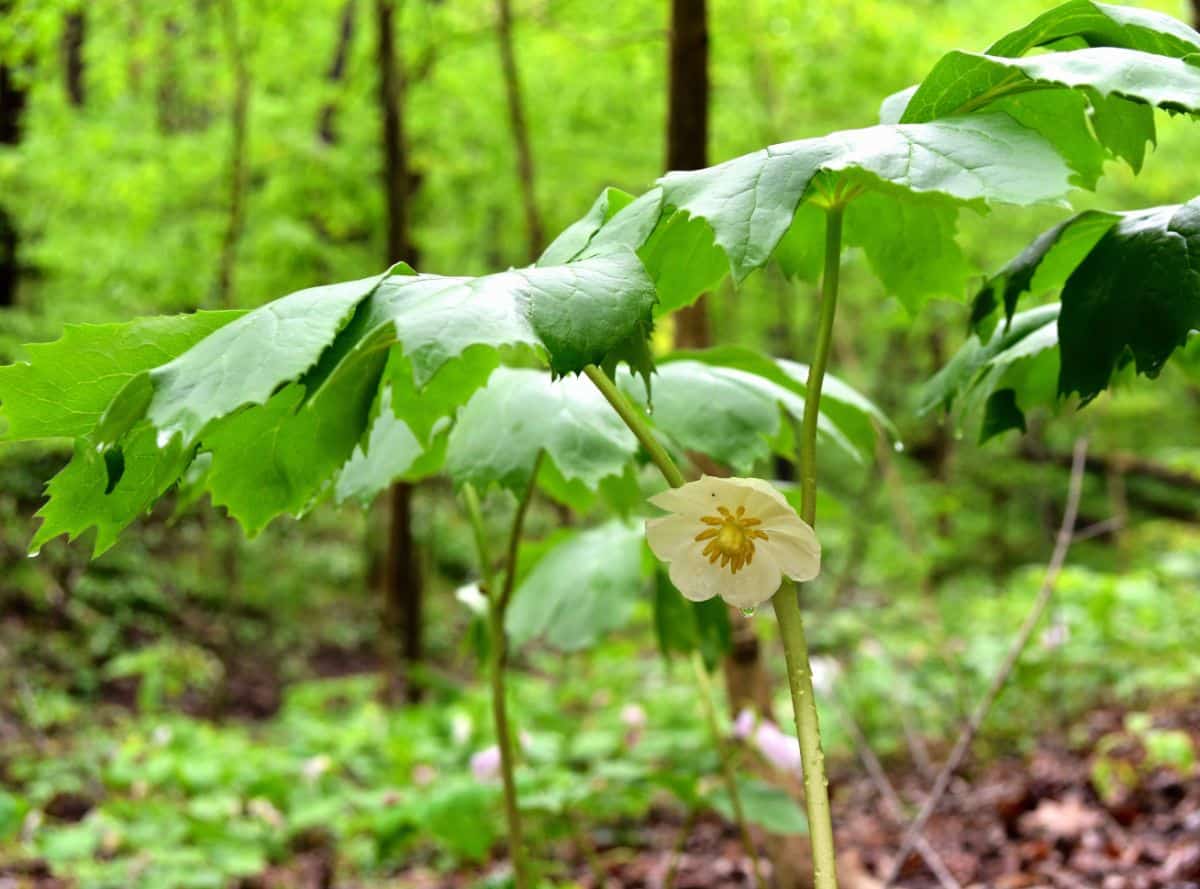
| Plant name: | Mayapple |
| Light requirements: | Shade |
| Water requirements: | High to moderate |
| Growing zone: | Zones 3 to 8 |
| Where to buy: | American Meadows |
Also known as the American mandrake, mayapples are iconic plants with umbrella-like, lobed leaves and attractive white flowers that are alluring in their delicacy. A long-lived perennial, mayapples are also considered to be spring ephemerals; however, they have a longer growing season than many of the other plants on this list. In fact, in moist and shaded areas, mayapples may not die back until late summer, but they fade earlier in hotter climates.
While they are slow-growing plants, mayapples are spread by seeds and rhizomes, and they form colonies. Since mayapples can grow densely together, they make attractive groundcovers. They can also be planted in wooded lots or under trees in shadier areas.
10. Sundial lupine (Lupinus perennis)

| Plant name: | Sundial lupine |
| Light requirements: | Full sun to part shade |
| Water requirements: | Low |
| Growing zone: | Zones 4 to 8 |
| Where to buy: | Botanical Interests; Wild Seed Project |
Sometimes categorized as a “summer ephemeral,” sundial lupines flower later than many other ephemerals, but they die back by mid-summer. Lovely, lavender-hued flowers appear on tall spikes and make a colorful display when planted in large groups. Flowers are further complemented by lupines’ whorled leaves, which add texture and color to garden beds.
While there’s no doubt that lupines are attractive plants, they are more than just ornamentals. Lupines are also members of the legume family, and they fix nitrogen in the soil, improving it over time. Rich in nectar, lupines will lure butterflies and hummingbirds to your landscape too!
11. Squirrel corn (Dicentra canadensis)
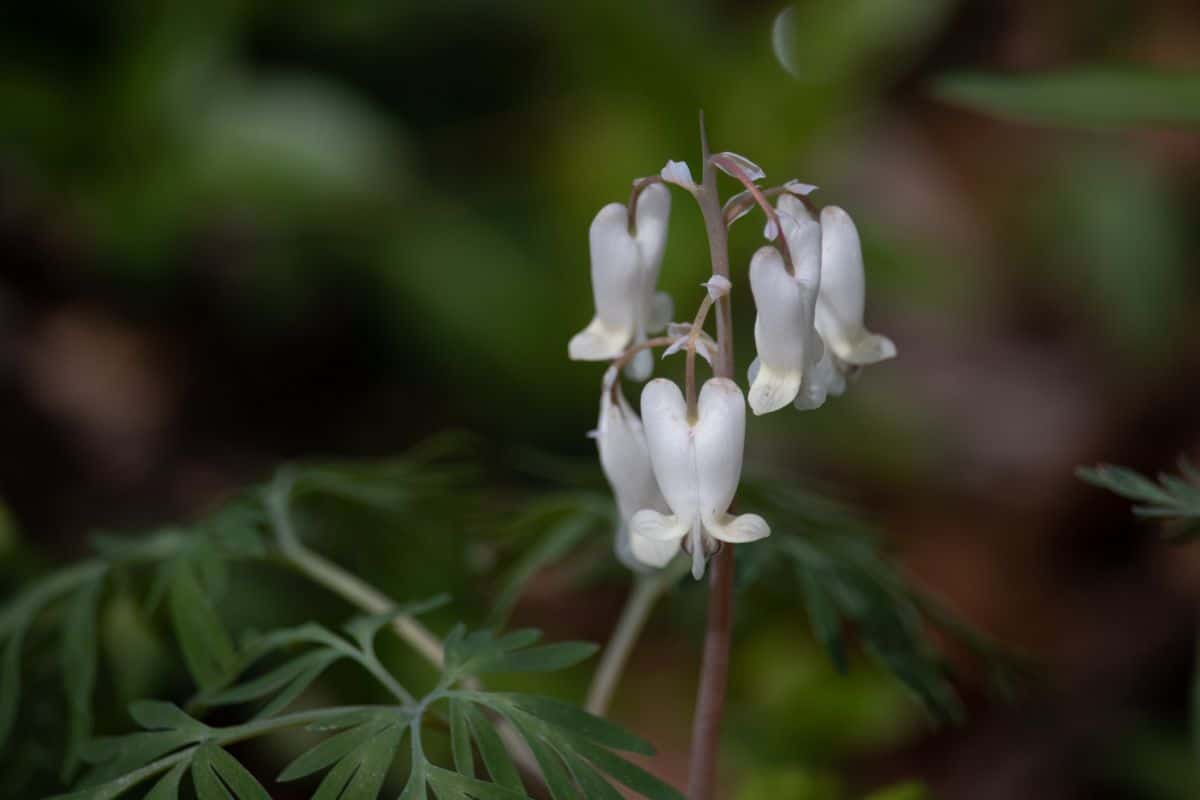
| Plant name: | Squirrel corn |
| Light requirements: | Shade |
| Water requirements: | High |
| Growing zone: | Zones 3 to 7 |
| Where to buy: | Carnivorous Plant Nursery |
Squirrel corn may have a funny name, but it is a lovely spring ephemeral that will liven up your gardens and put a smile on your face too! This plant got its name from its root system, which features yellow tubers that look a bit like corn. Those tubers are also a popular treat for squirrels, so you may want to keep roots enclosed in a protective bulb cage or loosely wrapped in chicken wire.
Squirrel corn is a close relative of bleeding hearts, but it stays much smaller and rarely reaches above 12” high. Like bleeding hearts, squirrel corn has lacy, fern-like leaves and heart-shaped blooms. Flowers are usually pale, pinkish-white, but they may also have a lavender cast.
12. Hepatica (Hepatica spp.)
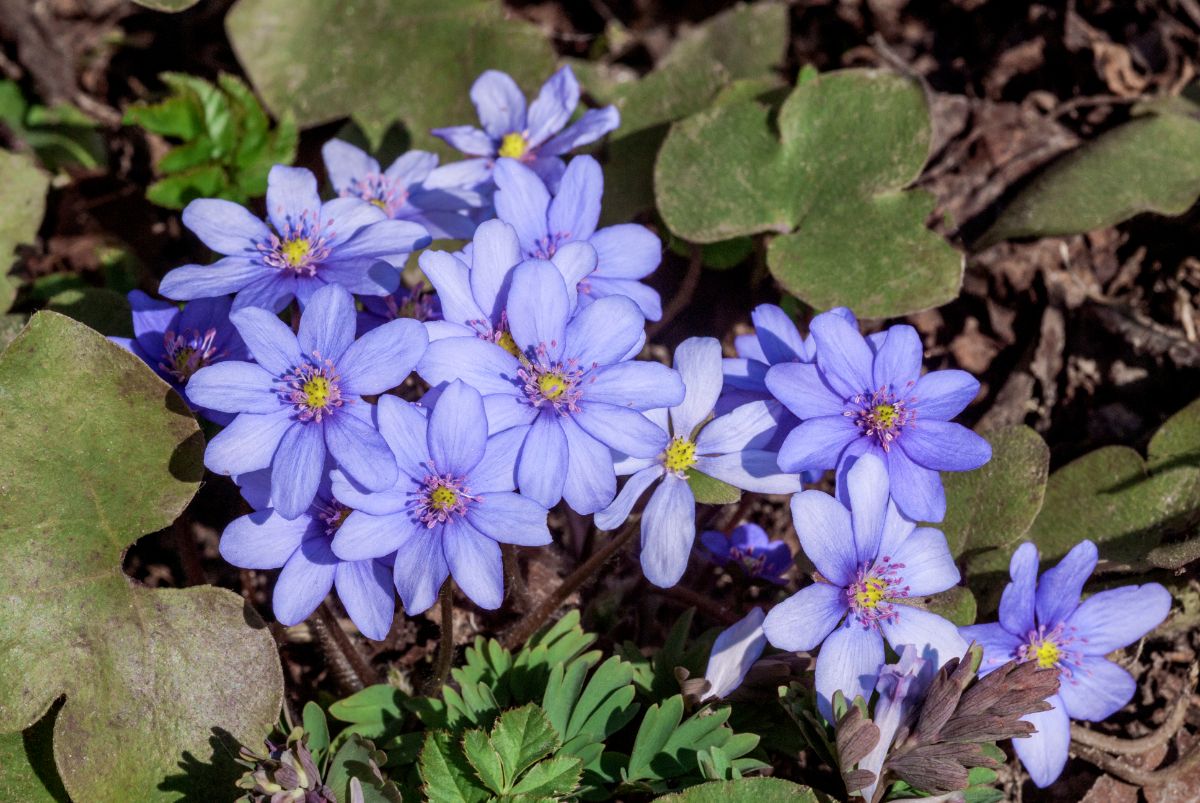
| Plant name: | Hepatica |
| Light requirements: | Shade |
| Water requirements: | High |
| Growing zone: | Zones 4 to 8 |
| Where to buy: | American Meadows |
Native to eastern North America, hepatica grows naturally in hickory or maple forests. This plant emerges cheerfully from the leaf-strewn woodland floor in early spring and can bloom pretty, purple flowers in March and April. Hepatica is a delicate plant that can be weighed down by heavy rain, so planting it in a sheltered area with partial shade is often best.
Hepatica has distinct lobed leaves that are said to resemble a liver. This is part of the reason why hepatica was once used as a folk remedy for liver ailments. Today, it is mostly kept as an ornamental, and it can look particularly eye-catching when paired with other ephemerals, like trillium and rue anemone.
13. Wild hyacinth (Camassia scilloides)
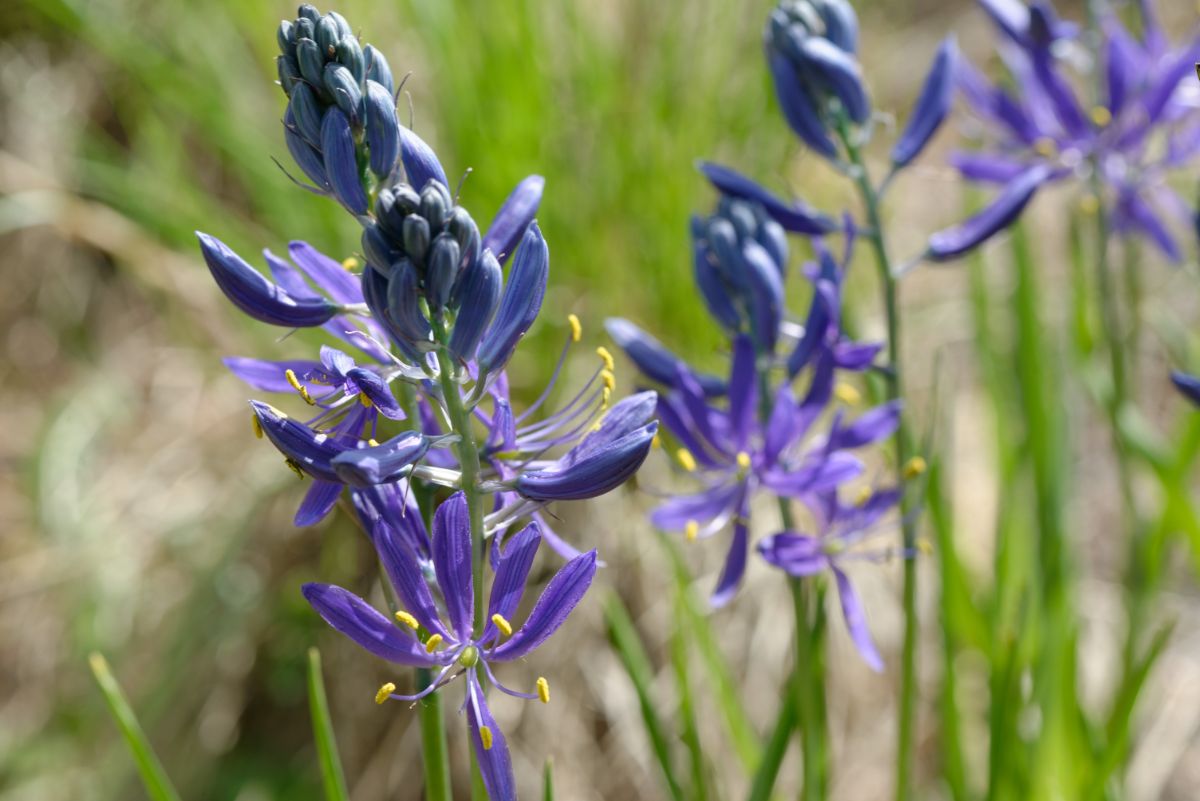
| Plant name: | Wild hyacinth |
| Light requirements: | Full sun to part shade |
| Water requirements: | Low |
| Growing zone: | Zones 4 to 8 |
| Where to buy: | Holland Bulb Farms |
Considered by many to be one of the most bewitching ephemerals, wild hyacinth produces tall spikes of pale blue to white flowers. Blooms are rich in nectar and pollen and make a wonderful addition to pollinator gardens. Wild hyacinth was eaten by Native American tribes; however, as it has some deadly lookalikes, it’s best not to try foraging this plant without an expert guide.
Wild hyacinth prefers slightly acidic soils and full sun, but it can grow in part shade too. Plants are generally started as bulbs. Those bulbs will eventually reproduce via offsets, which can be separated from the parent plant and sown elsewhere.
14. Ramps (Allium tricoccum)

| Plant name: | Ramps |
| Light requirements: | Shade |
| Water requirements: | High |
| Growing zone: | Zones 3 to 7 |
| Where to buy: | Amazon |
A close relative of onions and garlic, ramps are often foraged as a wild edible, but you can grow them in your backyard too! These scrumptious plants have a flavor that is a blend of onion and garlic and tastes delicious in homemade pesto!
As an ephemeral, ramps emerge from the soil in early spring and usually die back by mid-May. When growing these plants at home, try to imitate their natural environment as much as possible. In the wild, ramps grow under deciduous trees where the soil is moist and rich, and the sunlight is dappled.
15. Rue anemone (Thalictrum thalictroides)
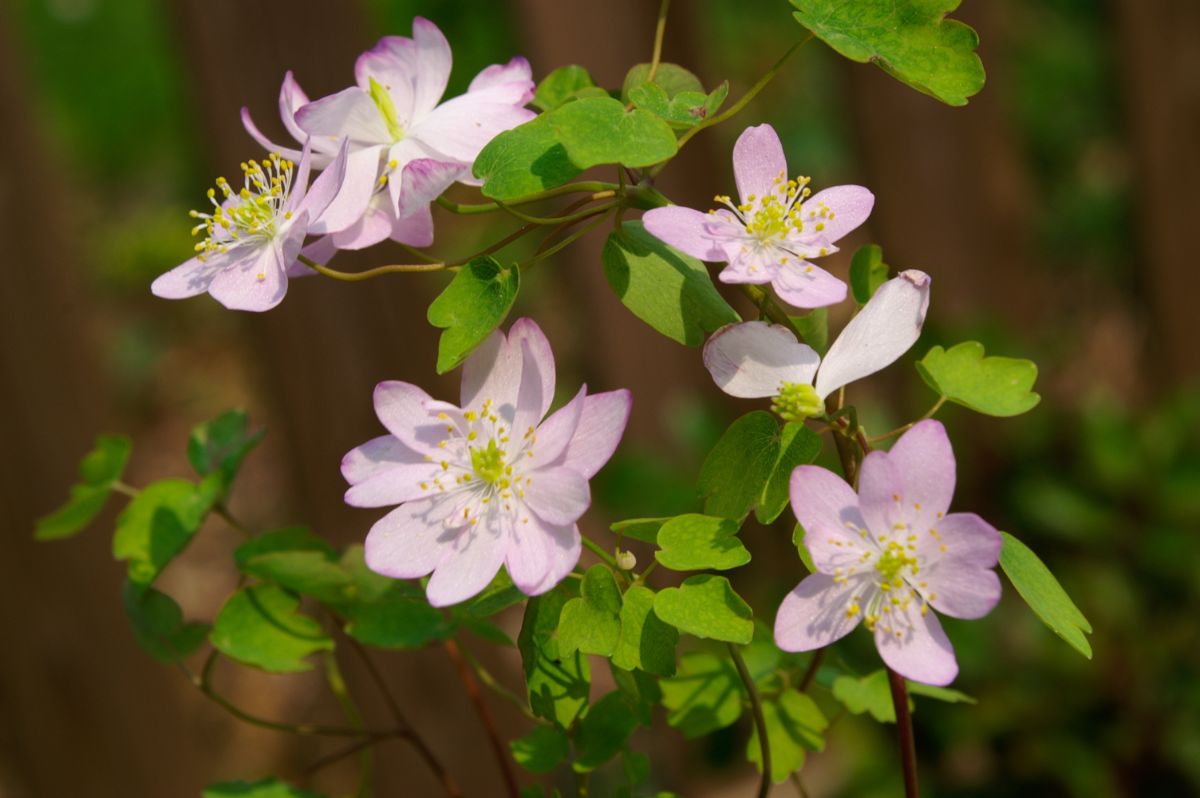
| Plant name: | Rue anemone |
| Light requirements: | Shade |
| Water requirements: | Moderate |
| Growing zone: | Zones 4 to 8 |
| Where to buy: | Prairie Moon Nursery |
Rue anemone are short but stately plants with airy foliage and bright flowers in pale pink or white. Once established, these plants are very easygoing, but like many other ephemerals, they are slow growers.
Once mature, rue anemone rarely grows above 6”, but they make an impressive impact when planted together in drifts. These flowers also pair beautifully with other ephemerals if you’d prefer a mixed garden bed with more variety.
16. Jack-in-the-pulpit (Arisaema triphyllum)
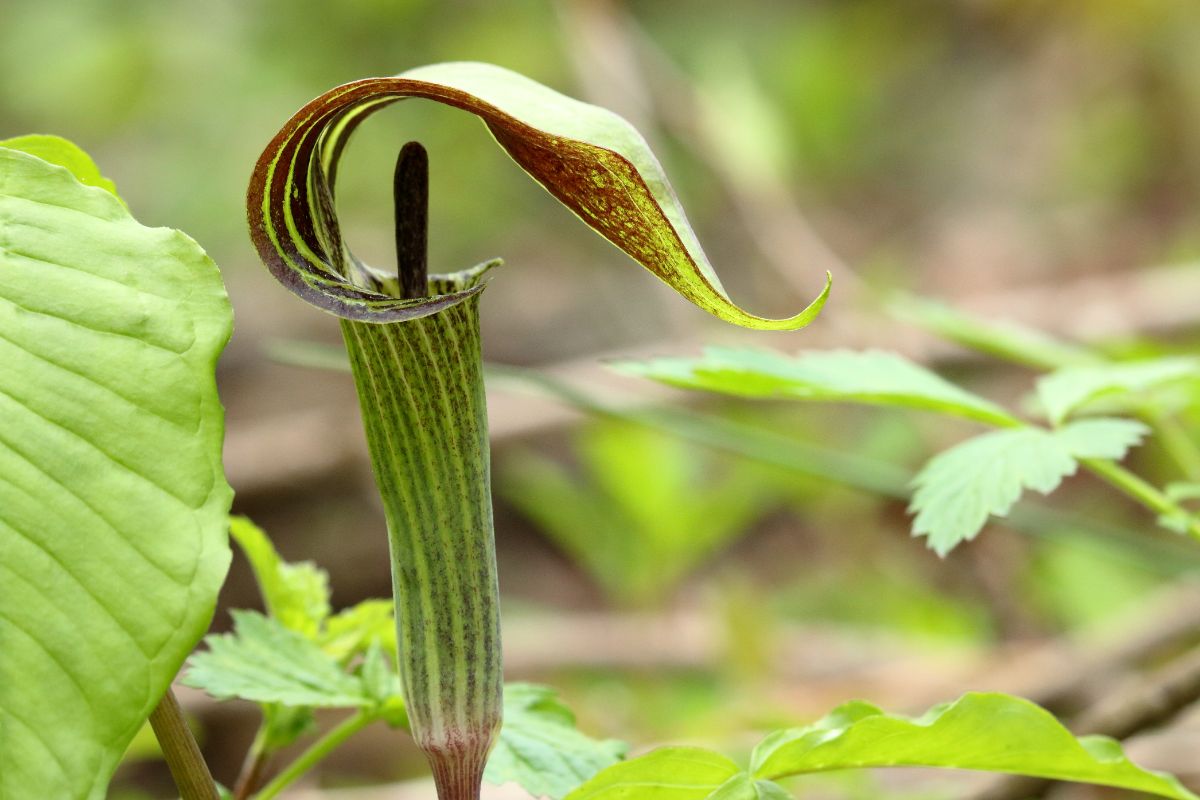
| Plant name: | Jack-in-the-pulpit |
| Light requirements: | Shade |
| Water requirements: | High |
| Growing zone: | Zones 4 to 9 |
| Where to buy: | American Meadows |
For something a bit different, you may want to try out jack-in-the-pulpit. Always a favorite among children, this curious little plant is a wonderful addition to fairy gardens, and it can complement other native plants, like foxglove, beautifully.
Jack-in-the-pulpit has a chalice-shaped form, which resembles pitcher plants and other carnivorous specimens. However, this ephemeral is not a carnivorous plant, although its shape is meant to attract insects for pollination purposes. When mature, jack-in-the-pulpit grows 1 to 2’ tall, and it blooms from April to June.
17. Dogtooth violet (Erythronium dens-canis)
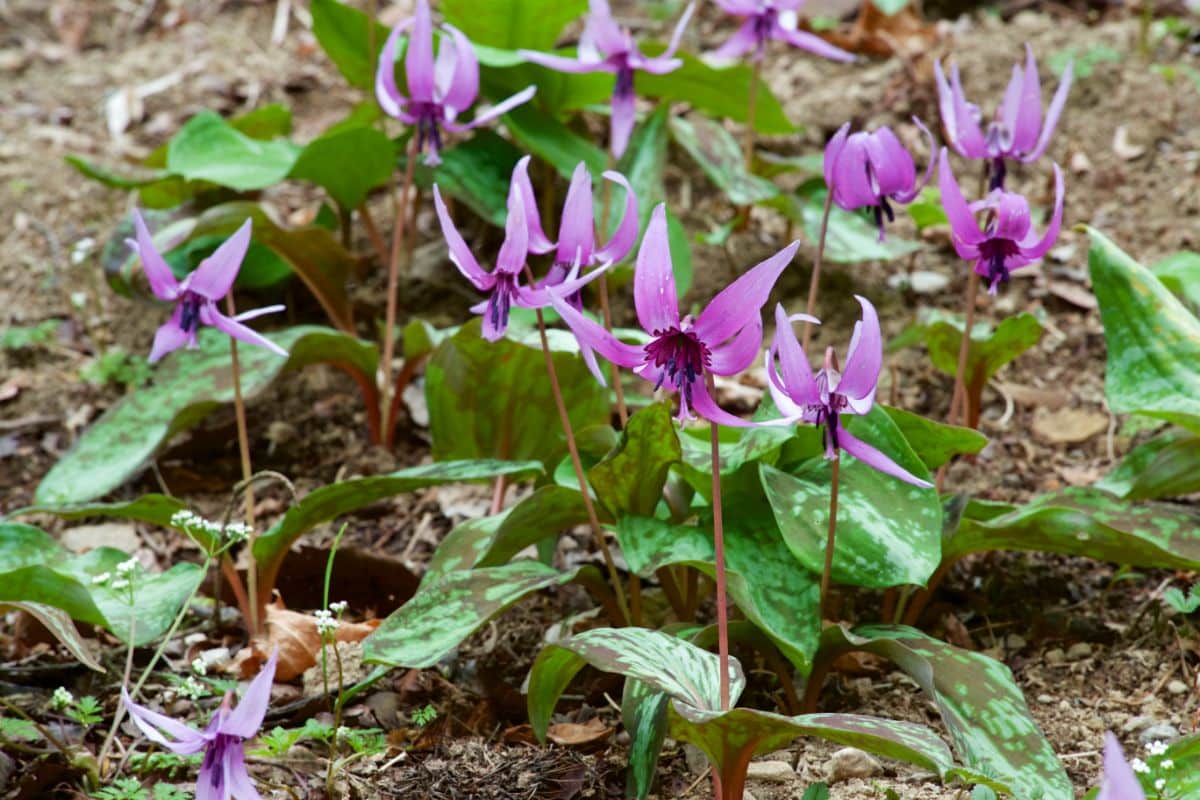
| Plant name: | Dogtooth violet |
| Light requirements: | Part shade |
| Water requirements: | High |
| Growing zone: | Zones 3 to 8 |
| Where to buy: | Breck’s |
Named for its oddly shaped root, which resembles a dog’s tooth, dogtooth violets are not related to common violets, although they do produce showy purple flowers. Those flowers open up during the day and close in the evening for an interesting garden display.
Dogtooth violets love lots of water, and they should never be allowed to fully dry out. Unlike many other ephemerals, they need to be watered during their dormant period, too; however, you don’t want to overdo it. Too much water can create soggy conditions that lead to root rot, so finding the proper moisture balance is key.
18. Shooting star (Primula sect. Dodecatheon)
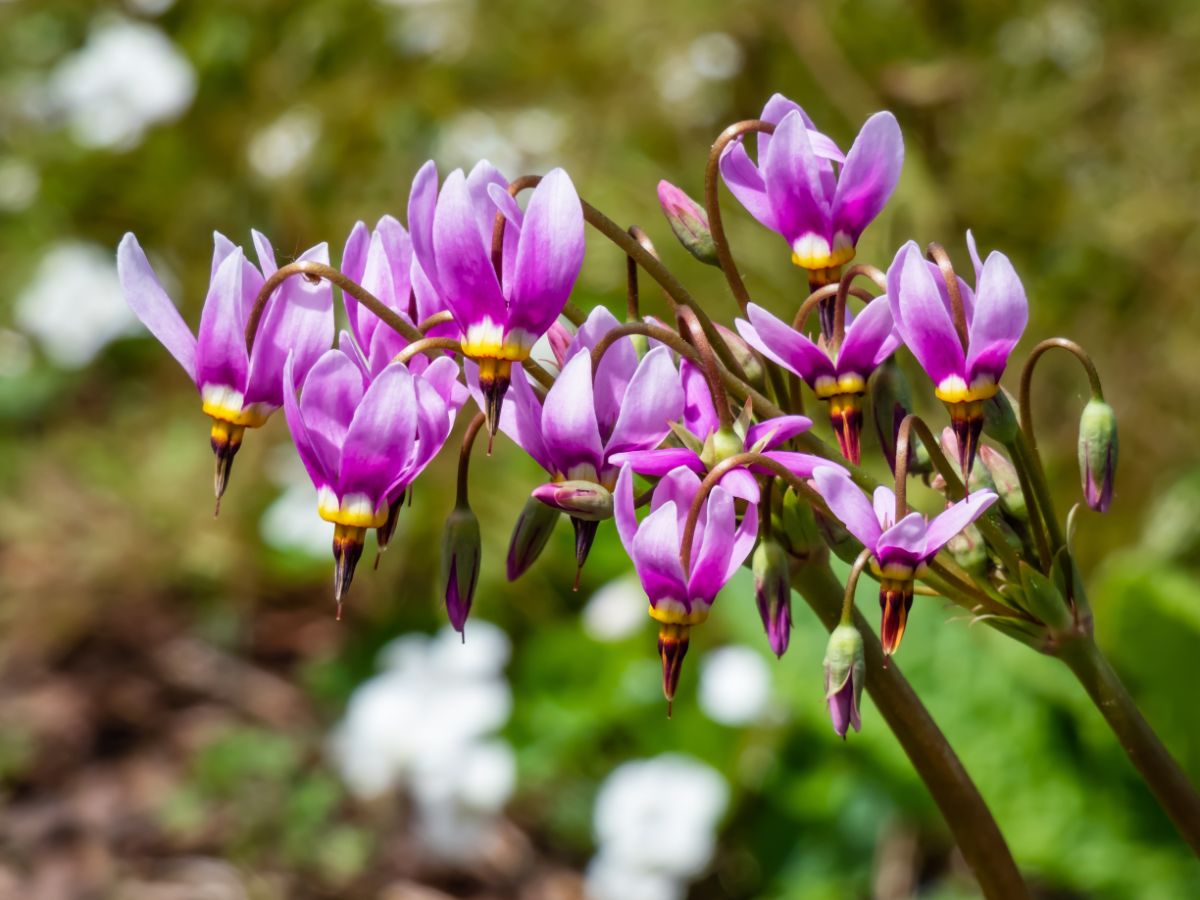
| Plant name: | Shooting star |
| Light requirements: | Part shade |
| Water requirements: | Moderate |
| Growing zone: | Zones 4 to 8 |
| Where to buy: | American Meadows |
Named for its pale purple, star-like flowers, shooting star blooms are angled and finely made and look very prim in garden beds. A short-lived perennial, shooting star may need to be replanted every few years; however, it often self-sows, so this is rarely necessary.
During the growing season, the shooting star should be provided with plenty of water, but its soil should be kept drier during its dormancy period. For better growth, add an annual application of compost to your garden beds to replenish the soil nutrients that your shooting stars crave.
19. Spring beauty (Claytonia virginica)
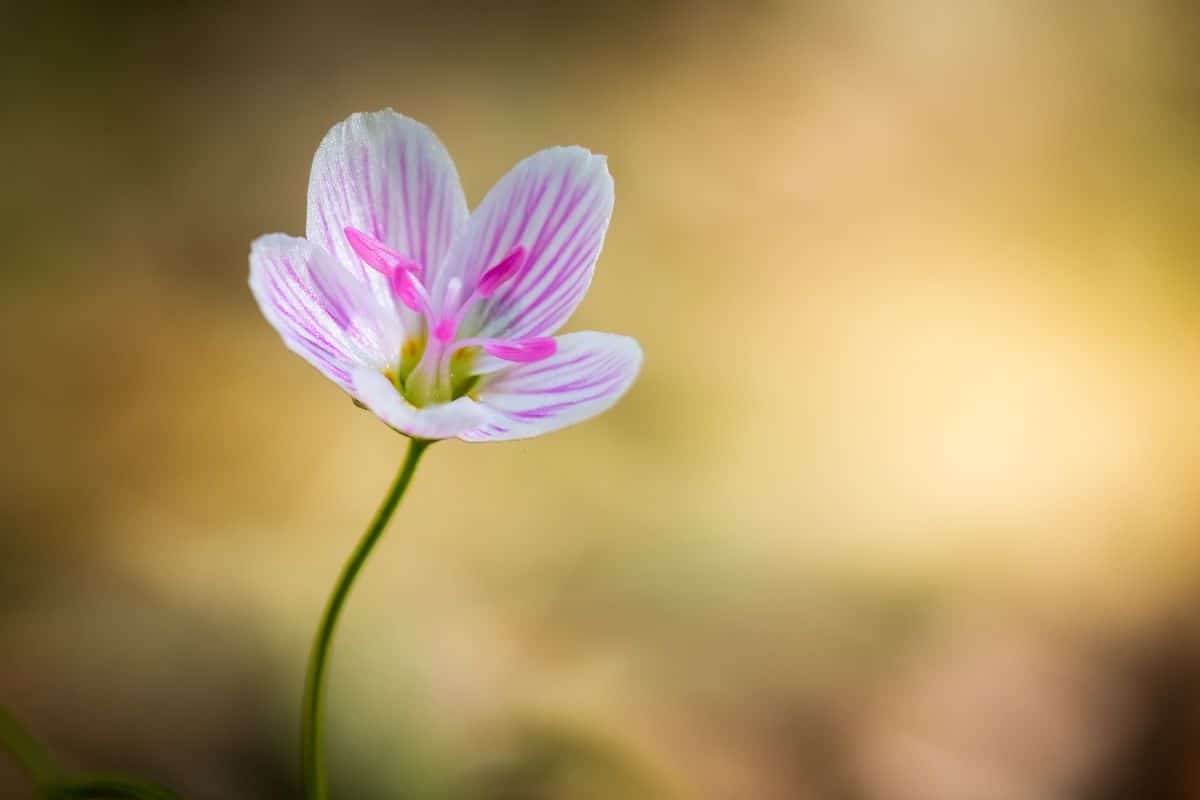
| Plant name: | Spring beauty |
| Light requirements: | Part shade |
| Water requirements: | Moderate to low |
| Growing zone: | Zones 5 to 9 |
| Where to buy: | Native Wildflowers Nursery |
Lupines and hyacinths are the sort of ephemerals that can really ‘wow’ garden visitors, but if you prefer a more subtle and natural look, spring beauty can be the perfect solution. These low-growing plants max out at around 2 to 16” tall and have grass-like leaves and small, rounded flowers that look a bit like strawberry blooms.
Often sold as bulbs, spring beauty should be sown in autumn to make sure your plants have plenty of time to settle in before the growing season. When sowing your spring beauties, plant bulbs about 3” deep and add an annual application of compost to keep your plants looking their best.
20. Dutchman’s breeches (Dicentra cucullaria)
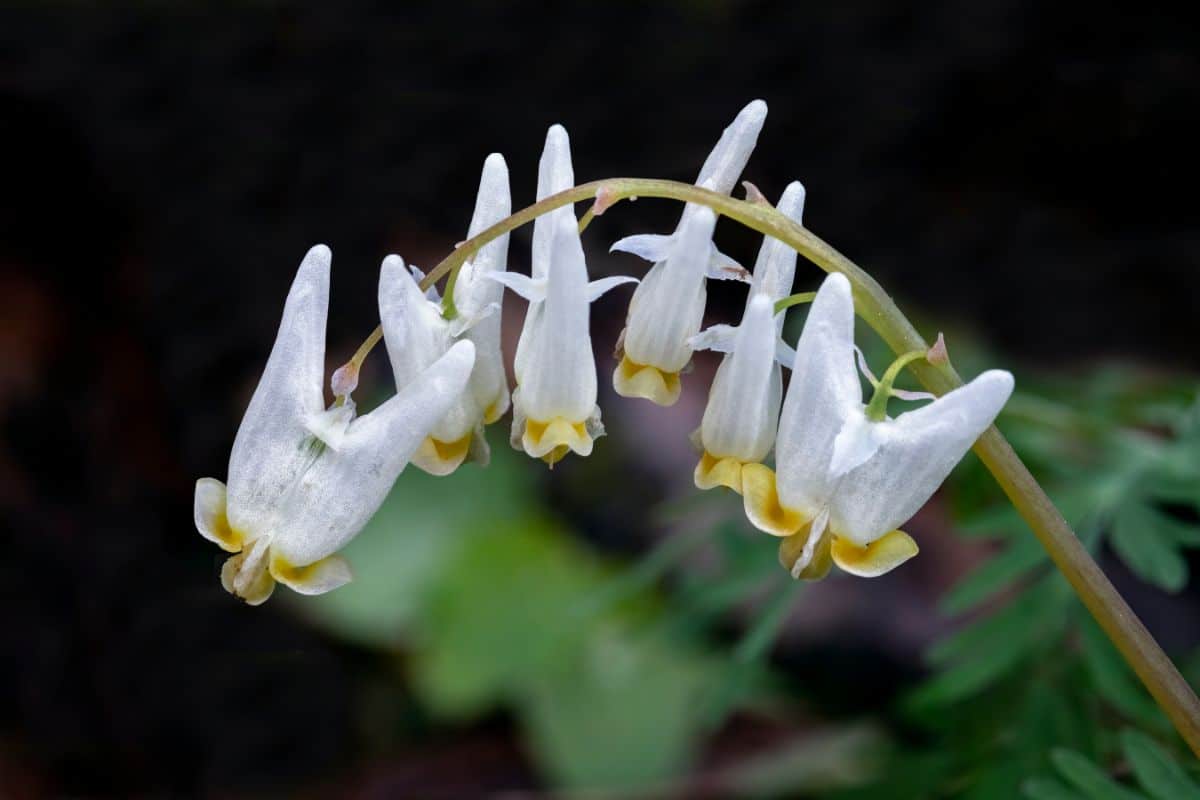
| Plant name: | Dutchman’s breeches |
| Light requirements: | Shade |
| Water requirements: | Moderate |
| Growing zone: | Zones 3 to 7 |
| Where to buy: | American Meadows |
Another relative of bleeding hearts, dutchman’s breeches have intriguingly shaped, white flowers that bloom on the underside of long and arching stems. While those flowers aren’t heart-shaped, you can clearly see the resemblance to bleeding hearts. And, like other members of this plant family, dutchman’s breeches has lacy leaves that lend a delicate feel to garden designs.
Once established, dutchman’s breeches is a low-maintenance plant, and it should come back year after year with little fuss. Just avoid overwatering it because it does not tolerate wet soil well.
21. Bitterroot (Lewisia rediviva)
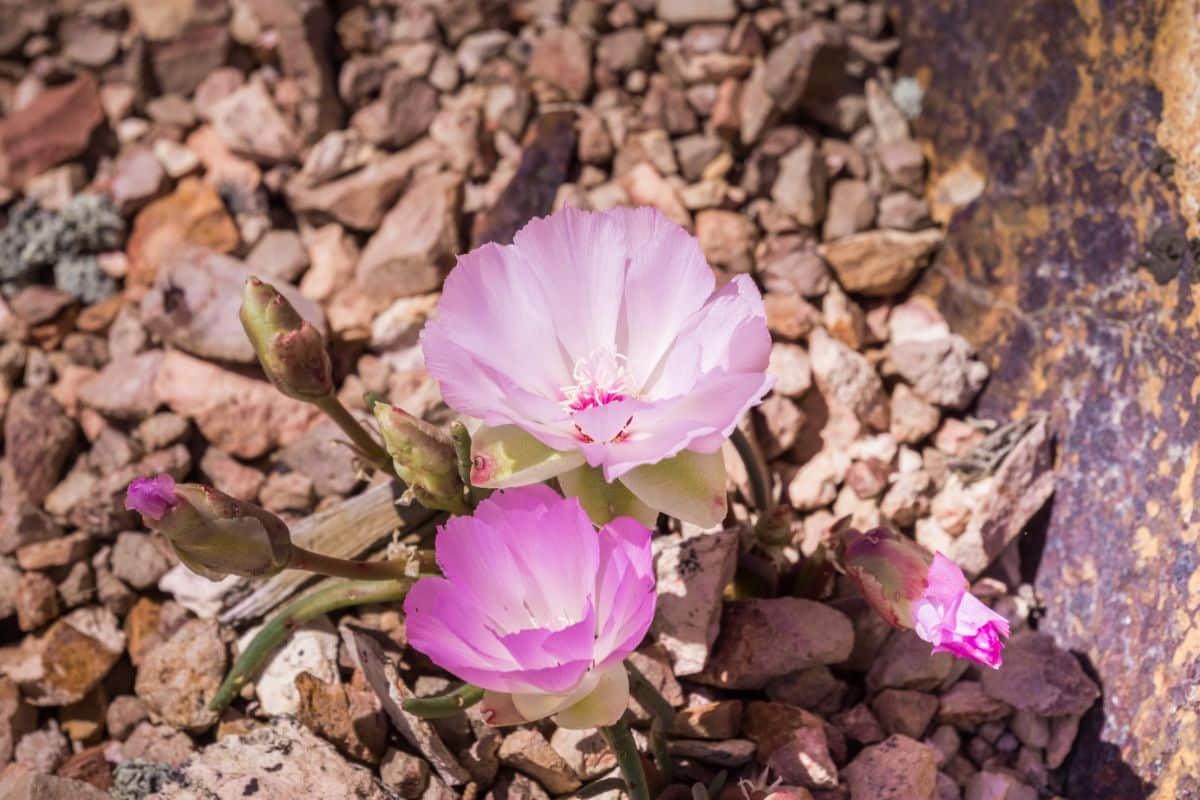
| Plant name: | Bitterroot |
| Light requirements: | Part shade |
| Water requirements: | Low |
| Growing zone: | Zones 4 to 8 |
| Where to buy: | Strictly Medicinal Seeds |
Native to the western United States, bitterroot is a low-growing plant that produces dainty pink or white blooms. Bitterroot is named after its long tap root, which bores into the soil and can reach water that is inaccessible to other plants. This makes bitterroot quite tolerant to drought, although it does prefer a bit of extra water when it’s in bloom.
As you might expect, bitterroot’s root is very bitter, but it was an important food source for Native Americans and was often served with cooked grouse. In the garden, bitterroot grows best in well-draining (and even rocky) soil.
Planting spring ephemerals
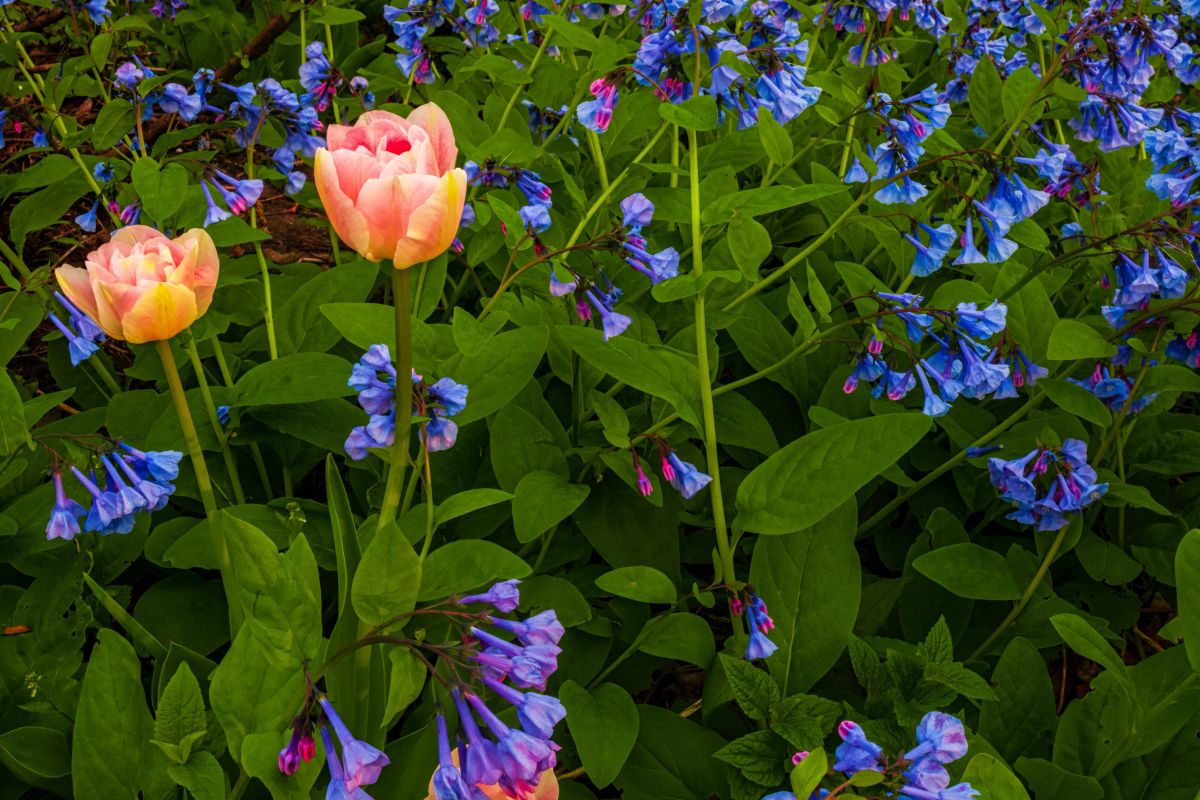
Spring ephemerals can be planted in either fall or spring. Fall sowing gives your plants more time to get established and develop a strong root system before the growing season ahead. Plants can also be sown when soil is first workable in early spring, but these plants may not bloom the first year if they are planted too late.
Different spring ephemerals will have different growing needs, so it’s a good idea to do a bit of research on the plant type you want to grow. Since many of these plants are native to woodlands, they’ll generally grow best in rich, moist soil and in areas of part shade. Some ephemerals will also grow in full sun, but you should avoid sowing them on the north side of your property as too much shade may slow down their growth.
When the heat begins to rise in spring, spring ephemerals will die back above ground, although their roots will continue to grow. While plants will return year after year, you’ll probably want to sow your ephemerals with later blooming specimens or foliage plants to maintain color in your beds after your ephemerals fade. Ferns, wild ginger, phlox, and bleeding hearts are all fine companions for ephemerals as they are easy-to-grow plants, and they can fill in your garden beds later in the season.
Conscious gardening
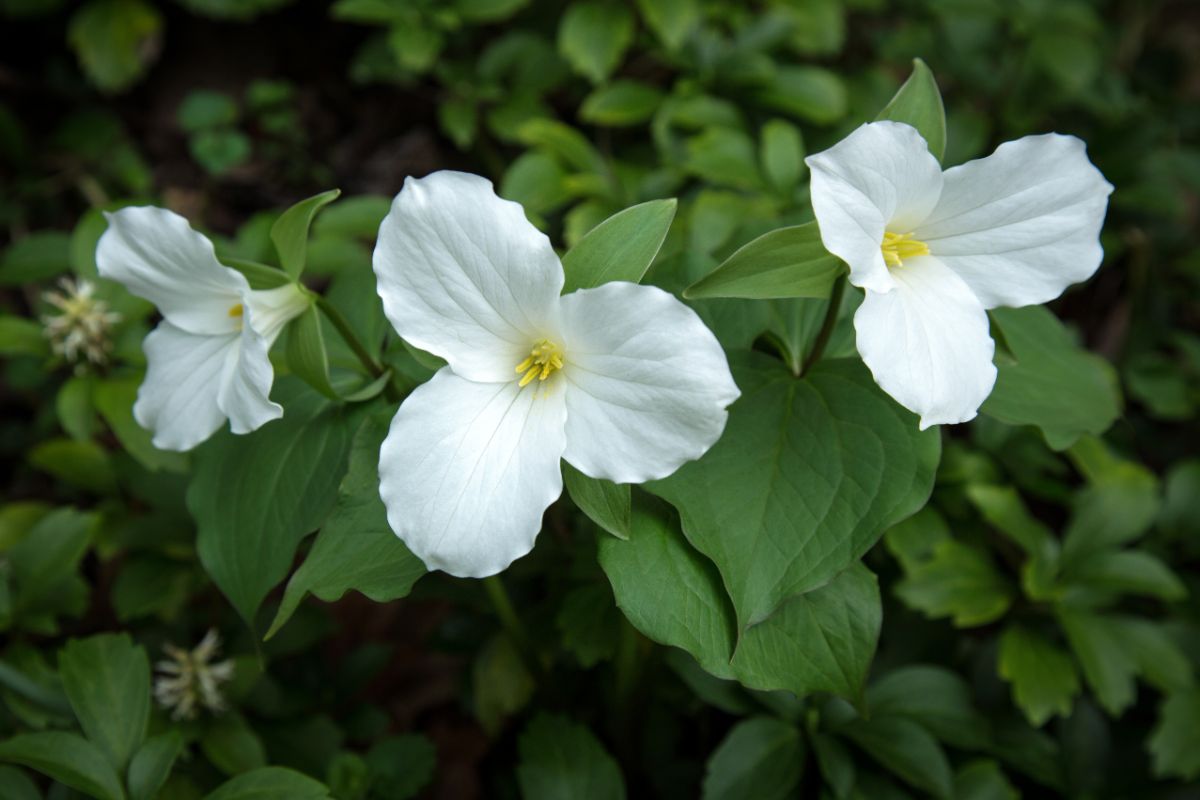
When it comes to gardening, it’s always important to know your supplier and to only purchase plants from reliable growers. This is especially important when working with native plants, as irresponsible harvesting of natives can devastate ecosystems and even endanger sensitive species.
Try to purchase native plants from growers who cultivate their own stock and don’t harvest directly from nature. Spring ephemerals, like trilliums, can take many years to establish themselves in the forest, and entire colonies can be wiped out by reckless harvesting.
Most native ephemerals can be grown from seed or rootstock that can be ordered online. You can also find many of these species at plant nurseries that specialize in native perennials. We’ve recommended some suppliers in this guide, but you can find additional growers with a bit of research.
Summary
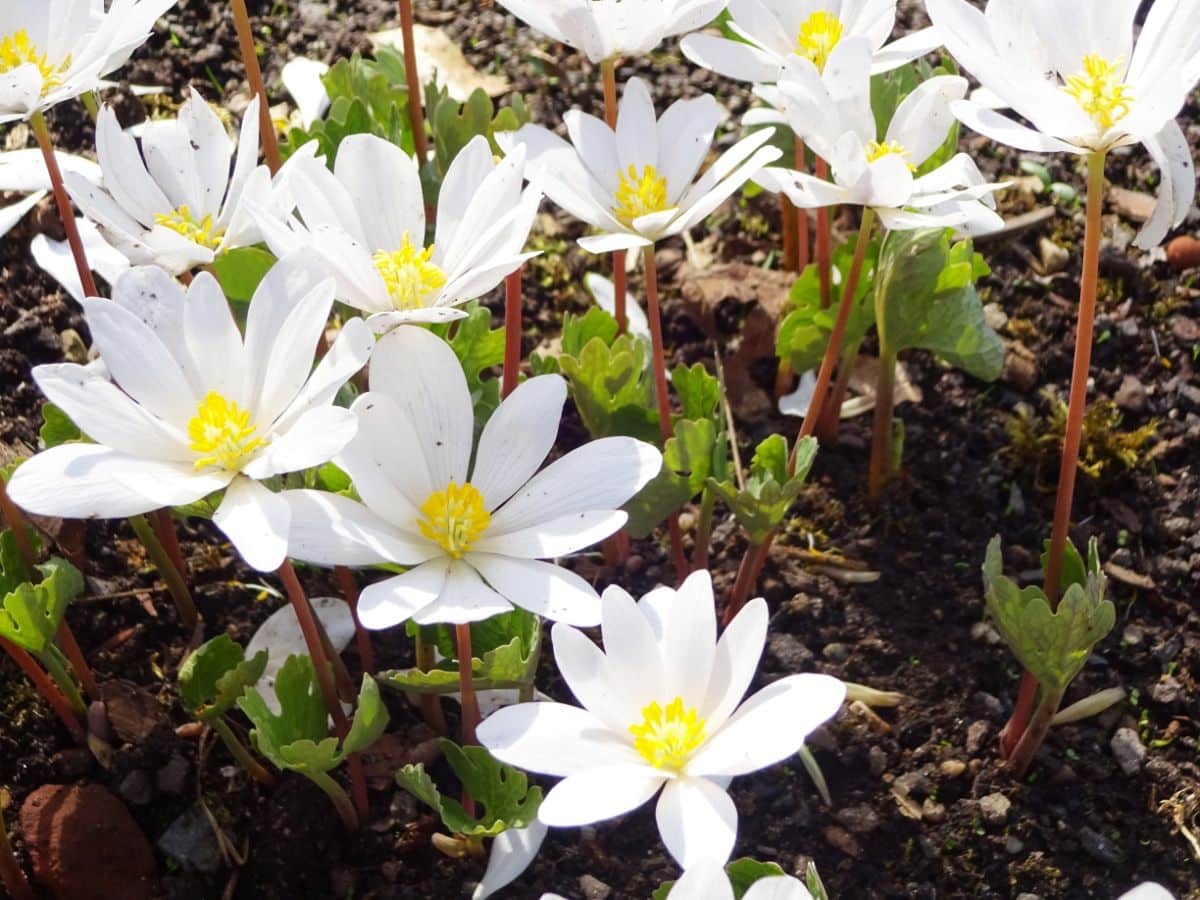
After a long cold winter, most gardeners can’t wait until spring arrives and they can start working their gardens again. When that first robin returns to your yard or crocuses begin to bloom, it’s easy to get excited. But if you want even more to look forward to in your spring garden, you may want to grow some native ephemerals.
These plants may not have the bold look of tulips or the flashy colors of hyacinths, but they add something different to garden beds. These delicate plants are much beloved by pollinators, and since they are often natives, they are more readily adaptable to your local growing conditions. Not to mention, they are darling plants with tons of charm too!
Since ephemerals don’t last long, they encourage us to get out in our gardens and appreciate nature in all its springtime glory. Once ephemerals fade, fall-planted bulbs are soon to emerge, signally that spring has finally sprung!

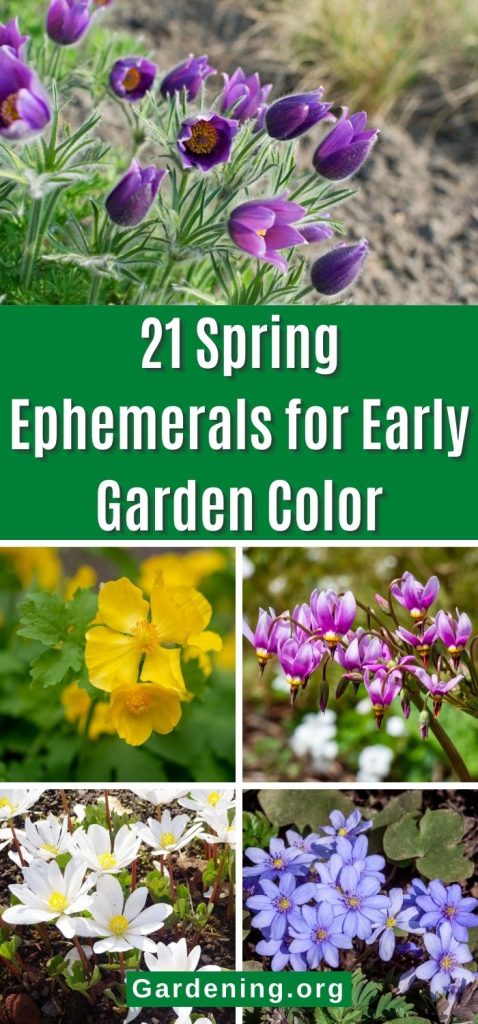
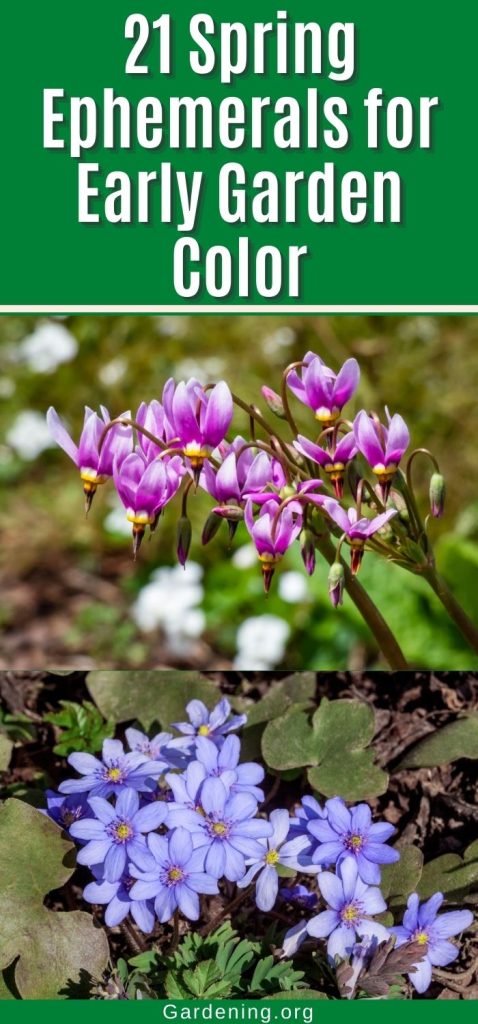
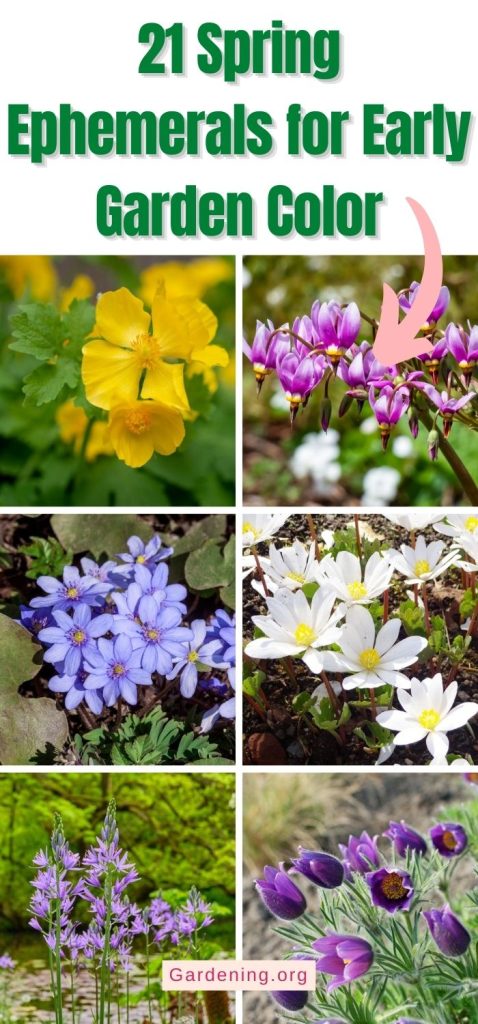


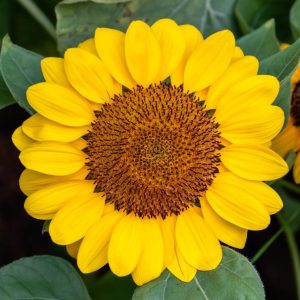
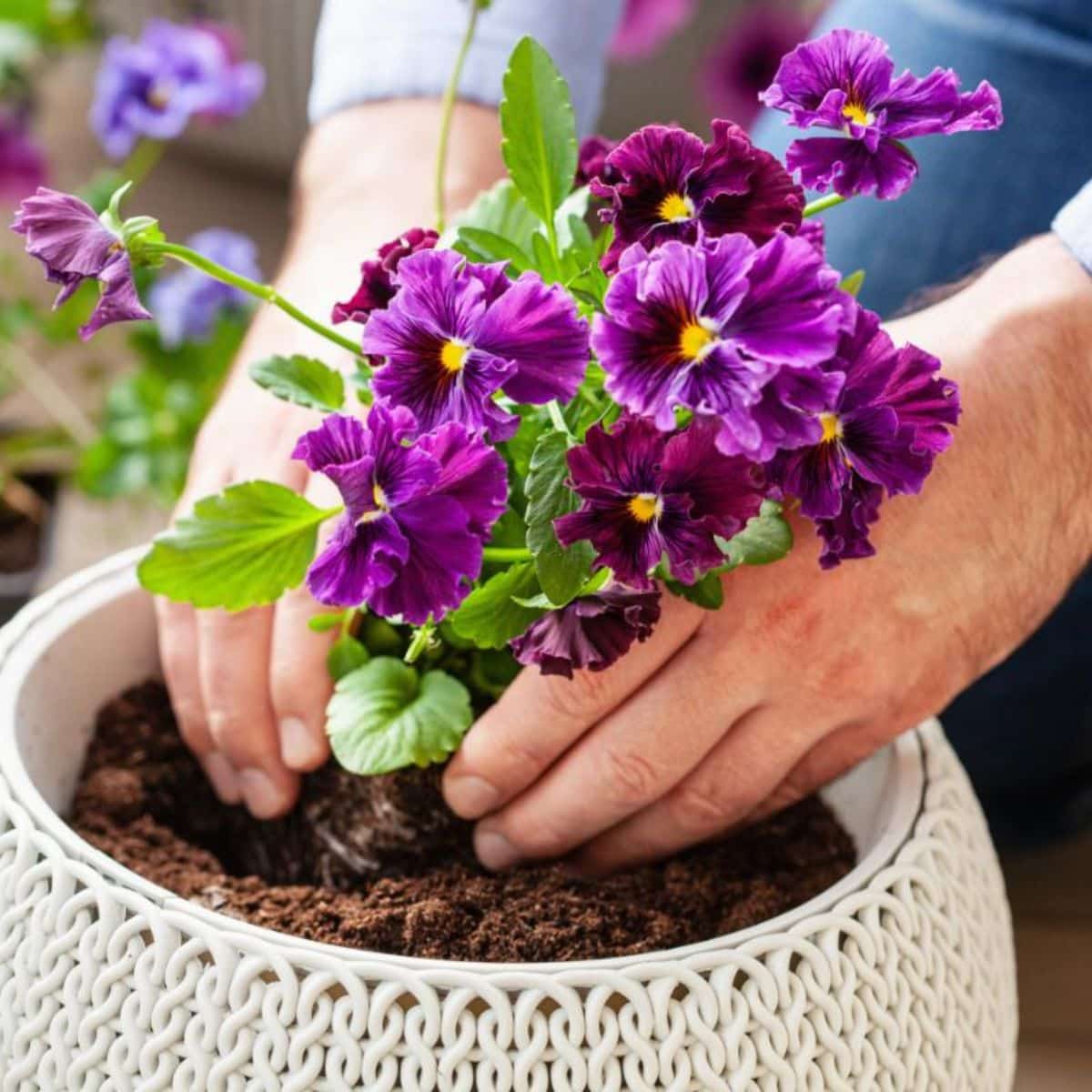
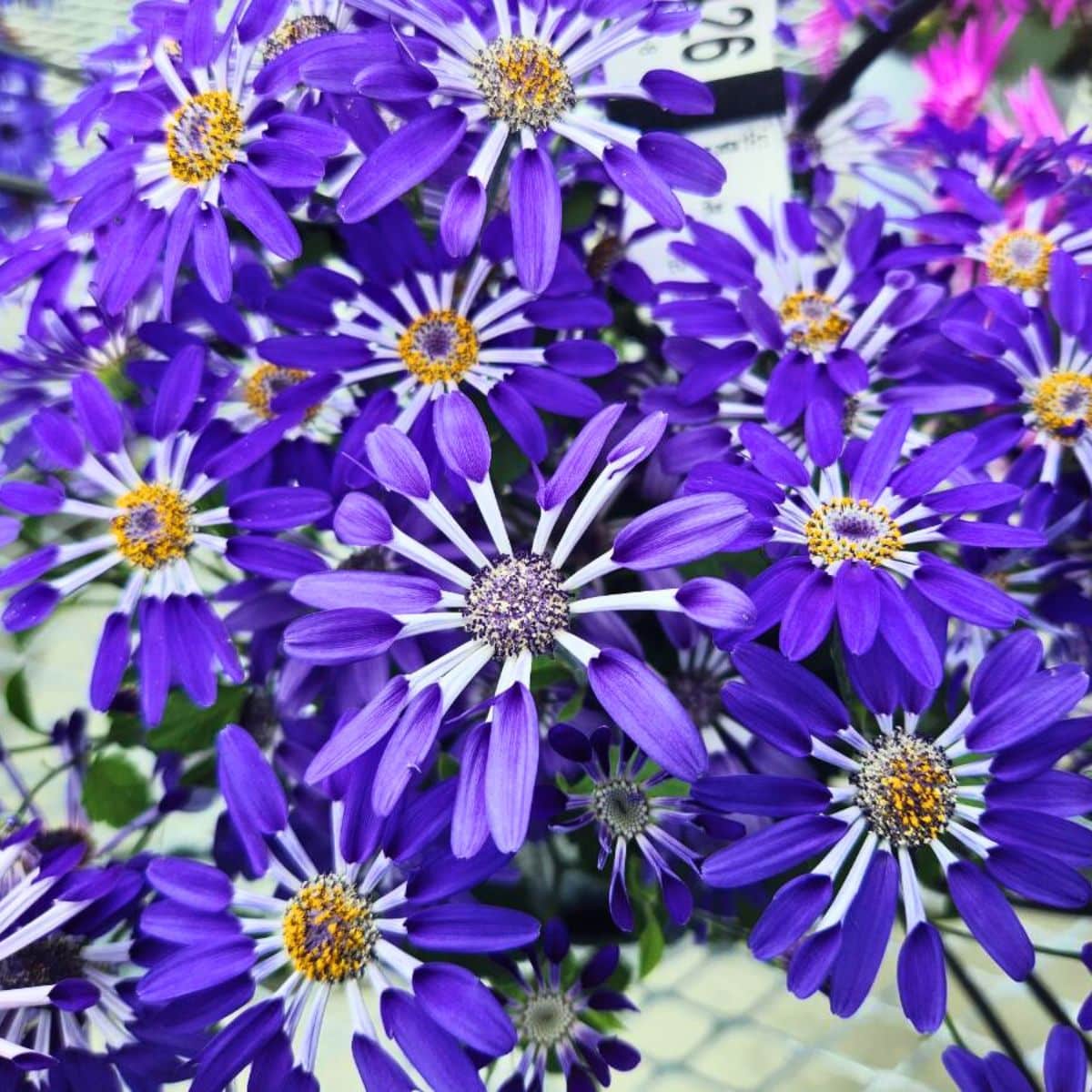
Leave a Reply